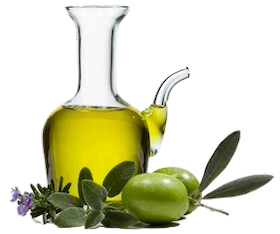Cooking with EVOO
Mediterraneans have long known that fresh extra virgin olive oil is the best and healthiest oil for cooking and frying.
So why do many Americans still believe that olive oil should only be used raw for dressing salads, dipping bread, or finishing? Too often, we hear people expressing concerns about cooking with extra virgin olive oil - either because of concern that it will lose its nutrients or because they fear that olive oil’s smoke point is too low for frying.
Vin’Oliva’s high polyphenol, low free fatty acid content and early harvest extra virgin olive oils offer a higher smoke point due to their quality and composition.
Myth: Extra Virgin Olive Oil loses its nutritional value when heated.
Truth: Contrary to what you may have heard, olive oil does not lose its health benefits or become unhealthy when heated.
Extra virgin olive oil is one of the most stable oils for cooking. Unlike other conventional (and refined!) cooking oils, extra virgin olive oil contains compounds and antioxidants that prevent the oil from breaking down under moderate heat. Extra virgin olive oil’s main health benefit is its fat composition. Olive oil is mostly monounsaturated fat, which remains the same after heating, even at high temperatures.
A study published in the Journal of Agriculture and Food Chemistry set out to put this myth to rest. In this study, two monovarietal extra virgin olive oils were heated to 180∘ C (356∘F) for 36 hours. They monitored oxidation and the minor compounds, including polyphenols. Even after heating the oil for a day and a half—many times longer than you would ever heat at home—they found that olive oil maintained most of its nutritional properties.*
*Source: J Agric Food Chem. 2007 Nov 14;55(23):9646-54. doi: 10.1021/jf070628u. Epub 2007 Oct 13
Myth: Olive oil’s smoke point is too low to cook with.
Truth: Olive oil is great for frying and has a smoke point that can handle the heat, even when cooking at high temperatures. Olive oil’s “low smoke point” is often cited as the reason why olive oil should not be heated or used for cooking. However, the smoke point of olive oil is comparable, and in some cases even higher than, common cooking oils such as soybean, sunflower, peanut, canola and corn oils.
It’s also important to keep in mind that most stovetop cooking is usually around 350°F - at or below the smoke point for olive oil. It is, therefore, unlikely that you will exceed the smoke point of olive oil with typical cooking methods.
So, don’t be afraid to use Seasons olive oil for more than just salads!
Sauté, fry, and make salad dressings with it—our olive oils are so fresh and delicious that they allow simple ingredients to shine. Fresh spinach or peas sautéed in extra virgin olive oil need nothing more than some sea salt and a light drizzle of12 Year Aged White Vinegar to turn them into a remarkably delicious side dish.
So why do many Americans still believe that olive oil should only be used raw for dressing salads, dipping bread, or finishing? Too often, we hear people expressing concerns about cooking with extra virgin olive oil - either because of concern that it will lose its nutrients or because they fear that olive oil’s smoke point is too low for frying.
Vin’Oliva’s high polyphenol, low free fatty acid content and early harvest extra virgin olive oils offer a higher smoke point due to their quality and composition.
Myth: Extra Virgin Olive Oil loses its nutritional value when heated.
Truth: Contrary to what you may have heard, olive oil does not lose its health benefits or become unhealthy when heated.
Extra virgin olive oil is one of the most stable oils for cooking. Unlike other conventional (and refined!) cooking oils, extra virgin olive oil contains compounds and antioxidants that prevent the oil from breaking down under moderate heat. Extra virgin olive oil’s main health benefit is its fat composition. Olive oil is mostly monounsaturated fat, which remains the same after heating, even at high temperatures.
A study published in the Journal of Agriculture and Food Chemistry set out to put this myth to rest. In this study, two monovarietal extra virgin olive oils were heated to 180∘ C (356∘F) for 36 hours. They monitored oxidation and the minor compounds, including polyphenols. Even after heating the oil for a day and a half—many times longer than you would ever heat at home—they found that olive oil maintained most of its nutritional properties.*
*Source: J Agric Food Chem. 2007 Nov 14;55(23):9646-54. doi: 10.1021/jf070628u. Epub 2007 Oct 13
Myth: Olive oil’s smoke point is too low to cook with.
Truth: Olive oil is great for frying and has a smoke point that can handle the heat, even when cooking at high temperatures. Olive oil’s “low smoke point” is often cited as the reason why olive oil should not be heated or used for cooking. However, the smoke point of olive oil is comparable, and in some cases even higher than, common cooking oils such as soybean, sunflower, peanut, canola and corn oils.
It’s also important to keep in mind that most stovetop cooking is usually around 350°F - at or below the smoke point for olive oil. It is, therefore, unlikely that you will exceed the smoke point of olive oil with typical cooking methods.
So, don’t be afraid to use Seasons olive oil for more than just salads!
Sauté, fry, and make salad dressings with it—our olive oils are so fresh and delicious that they allow simple ingredients to shine. Fresh spinach or peas sautéed in extra virgin olive oil need nothing more than some sea salt and a light drizzle of12 Year Aged White Vinegar to turn them into a remarkably delicious side dish.

